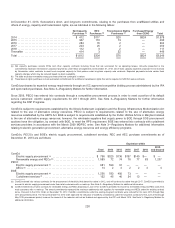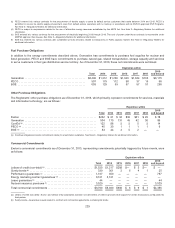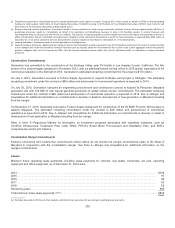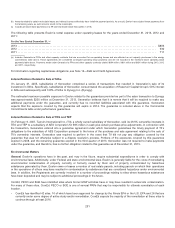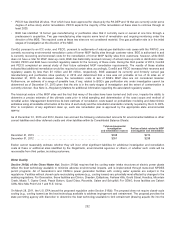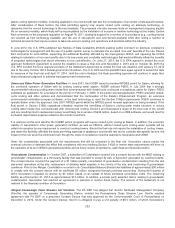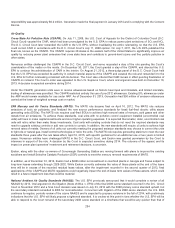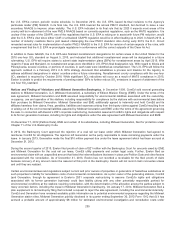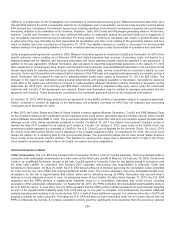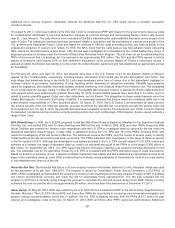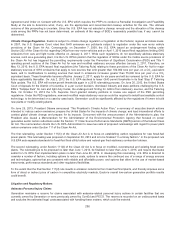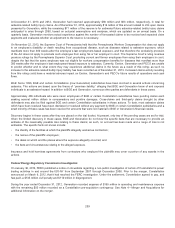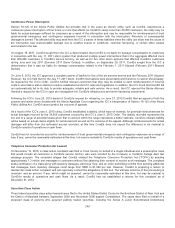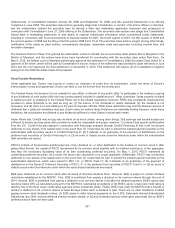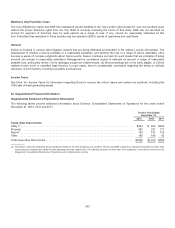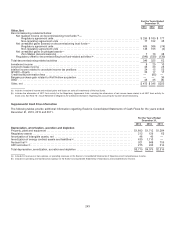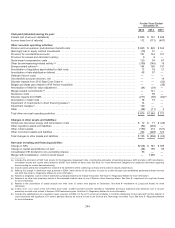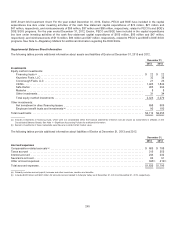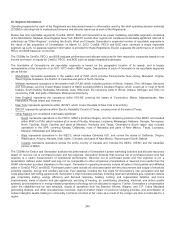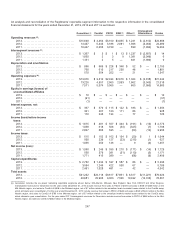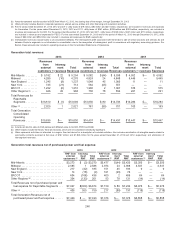ComEd 2013 Annual Report Download - page 244
Download and view the complete annual report
Please find page 244 of the 2013 ComEd annual report below. You can navigate through the pages in the report by either clicking on the pages listed below, or by using the keyword search tool below to find specific information within the annual report.Agreement andOrder on Consent withtheU.S. EPAwhich requiresthePRP’s to conductaRemedial Investigation andFeasibility
Study at thesite to determine what,ifany, are the appropriate andrecommendedcleanup activitiesfor thesite.The ultimate
outcomeofthis proceedingisuncertain.SincetheU.S. EPAhasnot selectedacleanup remedy andthe allocation ofthecleanup
costsamongthePRPs hasnot been determined, an estimate ofthe rangeof BGE’s reasonablypossible loss, if any, cannot be
determined.
Climate Change Regulation. Exelon is subjecttoclimate changeregulation or legislation at theFederal,regional andstate levels.
In 2007, theU.S. SupremeCourt ruledthat GHG emissionsare pollutantssubjecttoregulation under thenewmotor vehicle
provisionsoftheClean AirAct.Consequently, on December 7, 2009, theU.S. EPAissuedan endangerment findingunder
Section 202 oftheClean AirActregarding GHGs fromnewmotor vehiclesandon April1,2010 issuedfinal regulationslimiting GHG
emissionsfromcarsandlight trucks effectiveonJanuary2,2011. While such regulationsdo not specificallyaddress stationary
sources, such asageneratingplant,itis theU.S. EPA’s position that theregulation of GHGs under themobile source provisionsof
theClean AirActhastriggeredthe permittingrequirementsunder thePrevention of Significant Deterioration (PSD) andTitle V
operatingpermitsectionsoftheClean AirActfor newandmodifiedstationarysourceseffectiveJanuary2,2011.Therefore,on
May13,2010,theU.S. EPAissuedfinal regulations(theTailoringRule)relatingto these provisionsoftheClean AirActfor major
stationarysourcesof GHG emissionsthat applyto newsourcesthat emitgreater than 100,000 tonsper year,on a CO2equivalent
basis, andto modificationsto existingsourcesthat result inemissionsincreasesgreater than 75,000 tonsper year on a CO2
equivalent basis. Thesethresholds becameeffectiveJanuary2,2011,applyfor six yearsandwill bereviewedbytheU.S. EPAfor
future applicabilitythereafter.OnJuly2,2012 theU.S. EPAdeclinedto lower GHG permitthresholds initsfinal “Step 3”Tailoring
Rule update.TheU.S. EPAwill reviewpermitthresholds againin a 2015rulemakingprocess. OnJune 26, 2012,theUnitedStates
Court ofAppealsfor theDistrictofColumbia,inaper curium decision, dismissedindustryandstate petitionschallengingtheU.S.
EPA’s “Tailpipe Rule”for carsandlightdutytrucks, theendangerment findingfor GHG’s fromstationarysources, andtheTailoring
Rule.OnOctober 15, 2013 theU.S. SupremeCourt grantedindustrypetitionsto reviewone aspectofthePSD permitting
regulations. Under thePSD regulations, newandmodifiedmajor stationarysourcescouldberequiredto install bestavailable control
technology, to bedeterminedon a caseby casebasis. Generation couldbesignificantlyaffectedbytheregulationsifitwere to build
newplantsor modify existingplants.
OnJune 25, 2013,President Obama announced “ThePresident’s Climate Action Plan,” asummaryofexecutivebranch actions
intendedto:reducecarbon emissions; prepare theUnitedStatesfor theimpactsofclimate change;andleadinternational effortsto
combat global climate changeandprepare for itsimpacts. Concurrent withthe announcement oftheAdministration’s plan,the
President alsoissuedaMemorandumfor theAdministrator oftheEnvironmental Protection Agency that focusedon power
generation sector carbon reductionsunder theSection 111 NewSourcePerformanceStandards (NSPS) section ofthefederal Clean
AirAct.ThememorandumdirectstheU.S. EPAAdministrator to issue twosetsofproposedrulemakings withregardto power plant
carbon emissionsunder Section 111 oftheClean AirAct.
Thefirst rulemaking, under Section 111(b) oftheClean AirActis to focuson establishingcarbon regulationsfor newfossil-fuel
power plants. This rulemakingwasproposedon September 20,2013 andisto befinalized“inatimelyfashion.” Inthe proposedrule
U.S.EPAsetsseparate standards for fossil-fuel firedutilityboilersandnatural gasfiredstationarycombustion turbines.
Thesecondrulemaking, under Section 111(d) oftheClean AirActis to focuson modified, reconstructedandexistingfossilpower
plants. The rulemakingisto be proposedno later than June 1,2014, befinalizedno later than June 1,2015, andrequire that states
submittoU.S. EPAtheirimplementation plansno later than June 30,2016. Indevelopingthis rulemaking, U.S. EPAis directedto
consider a number offactors, includingoptionsto reducecosts, optionsto ensure thecontinueduseofa rangeofenergy sources
andtechnologies, optionsthat are consistent withreliable andaffordable power,andoptionsthat allowfor theuseofmarket-based
instruments, performancestandards andother regulatoryflexibilities.
Totheextent that thefinal Section 111(d) rule resultsinemission reductionsfromfossilfuel firedplants, andthereby imposessome
formofdirectorindirectpriceofcarbon incompetitive electricitymarkets, Exelon’s overall low-carbon generation portfolioresults
couldbenefit.
Litigation and Regulatory Matters
Asbestos Personal Injury Claims
Generation maintainsareservefor claims associatedwithasbestos-relatedpersonal injuryactionsincertainfacilitiesthat are
currentlyownedbyGeneration or were previouslyownedbyComEd and PECO. Thereserveis recordedon an undiscountedbasis
andexcludestheestimatedlegal costsassociatedwithhandlingthesematters, which couldbematerial.
238


